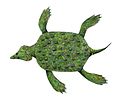
Plesiosaurus is a genus of extinct, large marine sauropterygian reptile that lived during the Early Jurassic. It is known by nearly complete skeletons from the Lias of England. It is distinguishable by its small head, long and slender neck, broad turtle-like body, a short tail, and two pairs of large, elongated paddles. It lends its name to the order Plesiosauria, of which it is an early, but fairly typical member. It contains only one species, the type, Plesiosaurus dolichodeirus. Other species once assigned to this genus, including P. brachypterygius, P. guilielmiimperatoris, and P. tournemirensis have been reassigned to new genera, such as Hydrorion, Seeleyosaurus and Microcleidus.
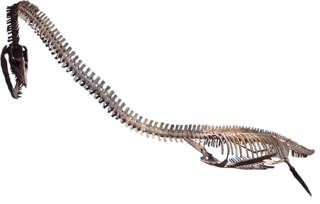
Elasmosauridae is an extinct family of plesiosaurs, often called elasmosaurs. They had the longest necks of the plesiosaurs and existed from the Hauterivian to the Maastrichtian stages of the Cretaceous, and represented one of the two groups of plesiosaurs present at the end of the Cretaceous alongside Polycotylidae.

Europasaurus is a basal macronarian sauropod, a form of quadrupedal herbivorous dinosaur. It lived during the Late Jurassic of northern Germany, and has been identified as an example of insular dwarfism resulting from the isolation of a sauropod population on an island within the Lower Saxony basin.
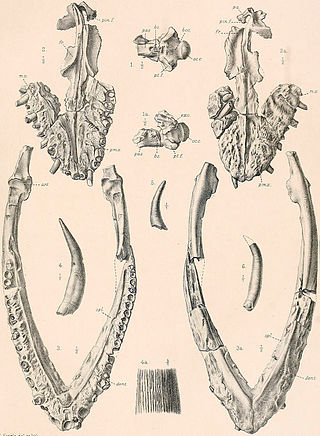
Muraenosaurus is an extinct genus of cryptoclidid plesiosaur reptile from the Oxford Clay of Southern England. The genus was given its name due to the eel-like appearance of the long neck and small head. Muraenosaurus grew up to 5.2 metres (17 ft) in length and lived roughly between 160 Ma and 164 Ma in the Callovian of the middle Jurassic. Charles E. Leeds collected the first Muraenosaurus which was then described by H. G. Seeley. The specimen may have suffered some damage due to the casual style of Charles Leeds’ collection. The first muraenosaur was recovered with pieces missing from the skull and many of the caudal vertebrae absent. Because the animal was described from Charles Leeds’ collection it was given the name Muraenosaurus Leedsi. M. leedsi is the most complete specimen belonging to the genus Muraenosaurus and also the only species that is undoubtedly a member of the genus. Two other species have been tentatively referred to as members of the genus Muraenosaurus: M. reedii and Muraenosaurus beloclis Seeley 1892, which in 1910 became the separate genus Picrocleidus.
Peloneustes is a genus of pliosaurid plesiosaur from the Middle Jurassic of England. Its remains are known from the Peterborough Member of the Oxford Clay Formation, which is Callovian in age. It was originally described as a species of Plesiosaurus by palaeontologist Harry Govier Seeley in 1869, before being given its own genus by naturalist Richard Lydekker in 1889. While many species have been assigned to Peloneustes, P. philarchus is currently the only one still considered valid, with the others moved to different genera, considered nomina dubia, or synonymised with P. philarchus. Some of the material formerly assigned to P. evansi have since been reassigned to "Pliosaurus" andrewsi. Peloneustes is known from many specimens, including some very complete material.

Anatosuchus is an extinct genus of notosuchian crocodyliforms discovered in Gadoufaoua, Niger, and described by a team of palaeontologists led by the American Paul Sereno in 2003, in the Journal of Vertebrate Paleontology.

Aphrosaurus was an extinct genus of plesiosaur from the Maastrichtian. The type species is Aphrosaurus furlongi, named by Welles in 1943. The holotype specimen was discovered in the Moreno Formation in Fresno County, California in 1939 by rancher Frank C. Piava. A second specimen - LACM 2832 - was also found in the same formation and initially diagnosed as a juvenile of the same species, but has since been removed from the genus.

Aristonectes is an extinct genus of large elasmosaurid plesiosaurs that lived during the Maastrichtian stage of the Late Cretaceous. Two species are known, A. parvidens and A. quiriquinensis, whose fossil remains were discovered in what are now Patagonia and Antarctica. Throughout the 20th century, Aristonectes was a difficult animal for scientists to analyze due to poor fossil preparation, its relationships to other genera were uncertain. After subsequent revisions and discoveries carried out from the beginning of the 21st century, Aristonectes is now recognised as the type genus of the subfamily Aristonectinae, a lineage of elasmosaurids characterized by an enlarged skull and a reduced length of the neck.
Morturneria is an extinct genus of plesiosaur from the Late Cretaceous of what is now Antarctica.
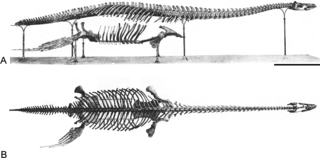
Brancasaurus is a genus of plesiosaur which lived in a freshwater lake in the Early Cretaceous of what is now North Rhine-Westphalia, Germany. With a long neck possessing vertebrae bearing distinctively-shaped "shark fin"-shaped neural spines, and a relatively small and pointed head, Brancasaurus is superficially similar to Elasmosaurus, albeit smaller in size at 3.26 metres (10.7 ft) in length as a subadult.

Cimoliasaurus was a plesiosaur that lived during the Late Cretaceous (Maastrichtian) of the eastern United States, with fossils known from New Jersey, North Carolina, and Maryland.

Tatenectes is a genus of cryptoclidid plesiosaur known from the Upper Jurassic of Wyoming. Its remains were recovered from the Redwater Shale Member of the Sundance Formation, and initially described as a new species of Cimoliosaurus by Wilbur Clinton Knight in 1900. It was reassigned to Tricleidus by Maurice G. Mehl in 1912 before being given its own genus by O'Keefe and Wahl in 2003. Tatenectes laramiensis is the type and only species of Tatenectes. While the original specimen was lost, subsequent discoveries have revealed that Tatenectes was a very unusual plesiosaur. Its torso had a flattened, boxy cross-section and its gastralia exhibit pachyostosis (thickening). The total length of Tatenectes has been estimated at 2–3 meters (6.6–9.8 ft).

Plesiopterys is an extinct genus of plesiosaur originating from the Posidonienschiefer of Holzmaden, Germany, and lived during the Early Jurassic period. It is thought to be the sister taxon to all other plesiosauroids including the Plesiosaurus, and is placed outside of the Plesiosauroidea group. Plesiopterys wildi is the one known species within the genus, and is 220 centimeters long, or about 7.2 feet, and its body and skull are both relatively small. It possesses a unique combination of both primitive and derived characters, and is currently displayed at the State Museum of Natural History, Germany.

Pachycostasaurus is an extinct Pliosauroid from the Oxford Clay formation of Peterborough, England.

Zuolong is an extinct genus of tetanuran theropod from the Late Jurassic period of China. The type and only species is Z. salleei. The generic name of Zuolong is in honor of General Zuo Zōngtáng with the Chinese word "long" which means dragon. The specific epithet "salleei" is in honor of Hilmar Sallee, who funded the expedition which led to the specimen's discovery.
Abyssosaurus is an extinct genus of cryptoclidid plesiosaur known from the Early Cretaceous of Chuvash Republic, western Russia. It possessed a shortened skull, and it has been suggested that it primarily inhabited the bathyal zone.

Aristonectinae is a subfamily of plesiosaurs in the family Elasmosauridae. It includes the Late Cretaceous plesiosaurs Aristonectes and Kaiwhekea, traditionally grouped with the Late Jurassic Tatenectes and Kimmerosaurus in the family Aristonectidae. They are distinguished by the fact that they have a very enlarged skull compared to the width of the body, a moderately short neck and more than 25 teeth in the maxilla.
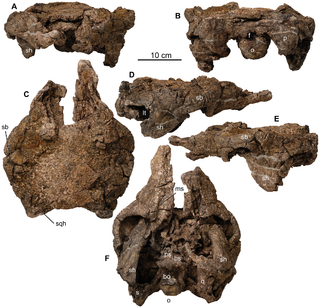
Europelta is a monospecific genus of nodosaurid dinosaur from Spain that lived during the Early Cretaceous in what is now the lower Escucha Formation of the Teruel Province. The type and only species, Europelta carbonensis, is known from two associated partial skeletons, and represents the most complete ankylosaur known from Europe. Europelta was named in 2013 by James I. Kirkland and colleagues. Europelta has an estimated length of 5 metres and weight of 1.3 tonnes, making it the largest member of the clade Struthiosaurini.

Mauriciosaurus is a genus of polycotylid plesiosaur from the Late Cretaceous of Mexico. It contains a single species, M. fernandezi, described in 2017 by Eberhard Frey and colleagues from a single well-preserved juvenile specimen about 1.9 metres long. Morphologically, it is overall most similar to the polycotyline polycotylids Trinacromerum and Dolichorhynchops. However, several features separate Mauriciosaurus from all other polycotylids, warranting the naming of a new genus. These include the sophisticated pattern of ridges on the bottom of the parasphenoid bone on its palate; the narrow openings in the palate bordered by the pterygoid bones; the lack of perforations in the surface of the coracoid; and the highly unusual arrangement of gastralia, or belly ribs, which is only otherwise seen in the non-polycotylid Cryptoclidus.
Luskhan is an extinct genus of brachauchenine pliosaur from the Cretaceous of Russia. The type and only species is Luskhan itilensis, named by Valentin Fischer and colleagues in 2017 from a well-preserved and nearly complete skeleton. As an early-diverging brachauchenine, Luskhan consequently exhibits an intermediate combination of traits seen in more basal and more derived pliosaurs. However, Luskhan departs significantly from other pliosaurs in that it exhibits a lack of adaptations in its skull to feeding on large prey; its slender snout, small teeth, and short tooth rows instead indicate a skull adapted for feeding on small, soft prey. With these features, it is the pliosaur that approaches closest to the distantly-related piscivorous polycotylids, having convergently evolved these traits more than 10 million years apart.
















